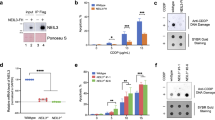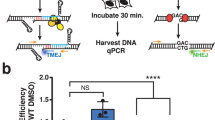Abstract
The 1-(2-chloroethyl)-1-nitrosoureas are potent anti-cancer drugs1,2 which produce DNA inter-strand cross-links in a two-step reaction sequence. The first step was proposed to be an addition of a chloroethyl group to a guanine-O6 position of DNA3; the second step, which occurs over a period of several hours in the absence of free drug3–6, could then form an inter-strand cross-link by the slow reaction of the bound chloroethyl group with a nucleophilic site on the opposite DNA strand. The delay between the formation of chloroethyl monoadducts and the formation of inter-strand cross-links allows time for a DNA repair mechanism, capable of removing the monoadducts, to prevent the cross-linking. We recently proposed this mechanism to account for a difference in inter-strand cross-linking between a normal and a transformed human cell strain6. Day and his coworkers (see refs 7, 8 and previous paper9) found that some human tumour cell strains (designated Mer− phenotype) are deficient in the ability to repair O6-methylguanine lesions in DNA. We therefore hypothesized that the repair function that removes O6-methylguanine residues from DNA would also remove chloroethyl monoadducts and hence prevent chloro-ethylnitrosourea-induced inter-strand cross-linking. We now present evidence that supports this hypothesis and indicates also that the O6-methylguanine repair confers resistance to cell killing by chloroethylnitrosourea.
This is a preview of subscription content, access via your institution
Access options
Subscribe to this journal
Receive 51 print issues and online access
$199.00 per year
only $3.90 per issue
Buy this article
- Purchase on Springer Link
- Instant access to full article PDF
Prices may be subject to local taxes which are calculated during checkout
Similar content being viewed by others
References
Wheeler, G. P. Handbk exp. Pharmac. 38, 65–84 (1975).
Carter, S. K. Cancer Treat. Rep. 60, 645–811 (1976).
Kohn, K. W. Cancer Res. 37, 1450–1454 (1977).
Lown, J. W., McLaughlin, L. W. & Chang, Y-M. Bioorgan. Chem. 7, 97–110 (1978).
Ewig, R. A. G. & Kohn, K. W. Cancer Res. 38, 3197–3203 (1978).
Erickson, L. C., Bradley, M. O., Ducore, J. M., Ewig, R. A. G. & Kohn, K. W. Proc. natn. Acad. Sci. U.S.A. 77, 467–471 (1980).
Day, R. S. III & Ziolkowski, C. H. Nature 279, 797–799 (1979).
Day, R. S. III, Ziolkowski, C. H., Scudiero, D. A., Meyer, S. A. & Mattern, M. R. Carcinogenesis 1, 21 (1980).
Day, R.S. III et al. Nature 288, 724–729 (1980).
Kohn, K. W., Erickson, L. C., Ewig, R. A. G. & Friedman, C. A. Biochemistry 15, 4629–4637 (1976).
Kohn, K. W. Meth. Cancer Res. 16, 291–345 (1979).
Kohn, K. W., Ewig, R. A. G., Erickson, L. C. & Zwelling, L. A. in A Laboratory Manual of Research Procedures (eds Friedberg, E. C. & Hanawalt, P. C.) (Dekker, New York, in the press).
Robins, P. & Cairns, J. Nature 280, 74–76 (1979).
Karran, P. & Lindahl, T. Nature 280, 76–77 (1979).
Renard, A. & Verly, W. G. FEBS Lett. 114, 98–102 (1980).
Author information
Authors and Affiliations
Rights and permissions
About this article
Cite this article
Erickson, L., Laurent, G., Sharkey, N. et al. DNA cross-linking and monoadduct repair in nitrosourea-treated human tumour cells. Nature 288, 727–729 (1980). https://doi.org/10.1038/288727a0
Received:
Accepted:
Issue Date:
DOI: https://doi.org/10.1038/288727a0
This article is cited by
-
Computational investigation of the carmustine (BCNU) alkylation mechanism using the QTAIM, IQA, and NBO models
Structural Chemistry (2021)
-
Molecular status of pituitary carcinoma and atypical adenoma that contributes the effectiveness of temozolomide
Medical Molecular Morphology (2014)
-
O6-methylguanine-DNA methyltransferase in equine sarcoids: molecular and epigenetic analysis
BMC Veterinary Research (2012)
-
F2A sequence linking MGMTP140K and MDR1 in a bicistronic lentiviral vector enables efficient chemoprotection of haematopoietic stem cells
Cancer Gene Therapy (2012)
-
Chemoprotection of human hematopoietic stem cells by simultaneous lentiviral overexpression of multidrug resistance 1 and O6-methylguanine-DNA methyltransferaseP140K
Gene Therapy (2010)
Comments
By submitting a comment you agree to abide by our Terms and Community Guidelines. If you find something abusive or that does not comply with our terms or guidelines please flag it as inappropriate.



